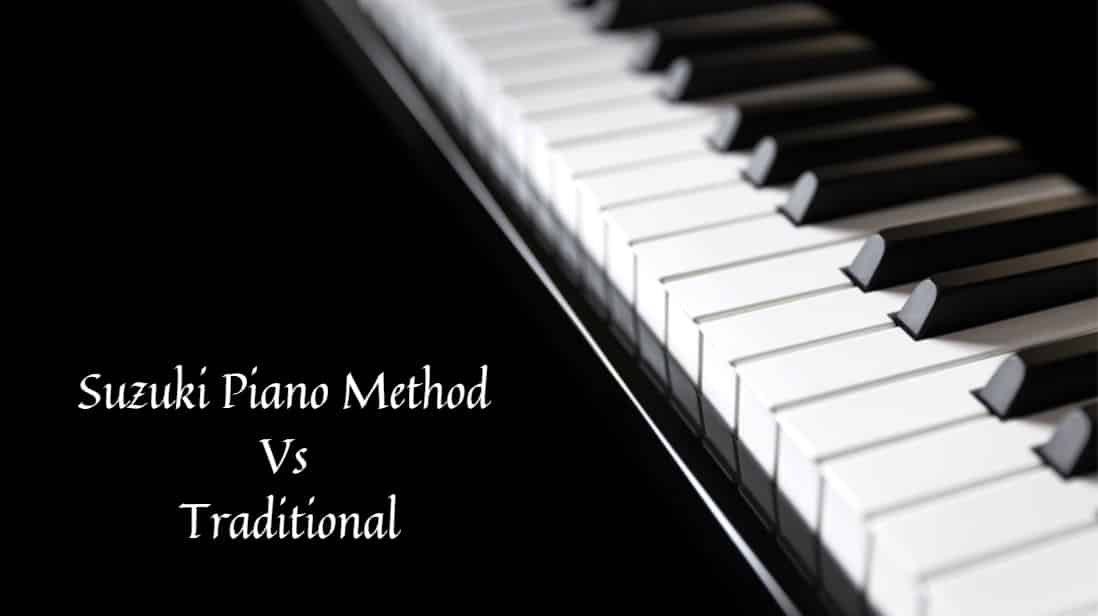
Learning any instrument can be a delight, a challenge, and a journey, and how you embark on this is a question in its own right. What method or style of learning is going to match your learning styles and needs? Will some approaches to learning the instrument benefit you more than others, allowing you to progress more quickly?
The piano is no exception when it comes to teaching methods. There are a plethora of different teaching styles that include Suzuki which we are going to delve into as a comparison to more traditional teaching methods.
Suzuki Piano Method Vs Traditional
The Suzuki methodology might initially spark a common image of a group of young violinists eagerly poised, bows up ready to play to their teacher at the front of the group. There is no music insight. The Suzuki philosophy not only incorporates a comprehensive teaching approach to violin playing (as Shin’ichi Suzuki was a brilliant violinist) but a whole range of other instruments from the exotic mandolin to the more common-place piano.
Suzuki’s method dates from the mid-20th Century and has at its heart the development of musicians through learning environments that parallel that of language. Where the link forms between language acquisition and the learning of an instrument are through the experience Suzuki himself had when trying to learn German.
Suzuki recounts that he noticed that children did not endure the same difficulties with language learning that he as an adult did. This led him to consider the possibility that if young children could learn new languages so freely that adopting a similar approach to them learning music might open up new possibilities.
What is appealing about the Suzuki philosophy is its organically inclusive approach. Suzuki firmly believed that every child, if taught in small steps and sensitively, could become a proficient violinist. This concept then extended to other instruments always with the idea that children especially, can learn from the ‘right’ learning environment.
Suzuki method promotes and encourages learning by ear rather than notation; beginning from the age of three to five years old; deep involvement in the music community and the avoidance of formal testing for musical aptitude that has traditionally discouraged many aspiring youngsters. A huge emphasis is also placed on the quality of teaching and thereby the training of teachers in the Suzuki methods and approaches.
Over the years this has led to the development of a huge range of teaching and learning materials for all the instruments; piano included. Opportunities for professionals to train in the Suzuki method remain vibrantly available and popular. Currently, the Suzuki Piano Method incorporates around seven volumes of music that in the initial phase make use of well-known tunes like ‘Twinkle, twinkle, Little Star’, as well as other folk songs. As the volumes advance, the music begins to include repertoire from the Baroque, Classical, Romantic, and Modern piano catalog but with the emphasis remaining on learning by ‘ear’ rather than by eye.
Here is where the teaching methodologies begin to differ. Traditionally, whether one is approaching the leaning through the ‘Alfred Method’ the ‘Faber & Faber Method’, the ‘Bastien Method’ or even the ‘John Thompson Method’, the more traditional delivery of lessons for the young or beginner pianist centered on learning from notation. This is not to say that teachers who use these methods do not encourage or make good use of learning by ear, but that Suzuki places this aural learning at the heart of its method.
If you think about the development of young children and how they learn, much of what Suzuki believed makes sense. Children, especially if we’re considering children as young as three years old, do not commonly read. They learn through experiences, repetition, and in particular from the environment in which they find themselves. A very young child may not yet have the capacity to grasp notation and let’s remember pianists need to eventually cope with two staves, but they almost instinctively sing, clap, and dance to musical stimuli. Suzuki recognized this and built his approach to learning from here forward.
Suzuki was a strong believer in the fact that if children begin to learn the piano, for instance, at an early age they may not develop reading skills but they do gain the advantage of strength in their hands and finger dexterity. They also develop a ‘sense’ of musical form that emerges from being able to sing and then play simple melodic material. Suzuki’s method is an organic one that progresses from a very human starting point that we all experience.
From a more ‘traditional’ perspective criticism leveled at the Suzuki method often begins with the claim that those who learn this way seldom develop adequate reading abilities. Aside from this claim holding little credibility or having a foundation, in fact, it is interesting perhaps to reflect on just how little music is actually notated.
The idea of teaching, especially young children, from a notation system almost seems counter-intuitive and almost deliberately exclusive. Other observations about the weaknesses in the Suzuki method emphasize posture, technique, and interpretative ability. As the Suzuki method encourages group experience and group performance, the thought comes that the emerging musician does not have the opportunity to learn the finer, expressive implications of music and become a genuinely individual performer.
It seems to me that many of these dissenting voices are sounds of the past. There is a range of methods of learning piano available to today’s aspiring musicians, enough to satisfy or match the aims of teachers and students alike. There are clear benefits, it seems to me, to the Suzuki method especially if we are teaching very young students.
I have often found that students that have come to me to learn from other teachers are lacking in aural ability even if their reading facility is strong. This imbalance I feel can in some cases be attributed to a notational approach to learning the instrument at the expense of encouraging the development of ear-to-hand coordination.
As such, I cherry-pick from different methods of learning to ensure that there is an adequate balance between ear and eye in every musician, with a genuine sense of gratitude to Suzuki.

This is all a bit too simplistic. Eg learning by ear covers picking out melodies to picking out harmonic and rhythmic sequences, guessing from experience what comes next. etc. Sight reading involves memories of note sequences and clusters but also experience of sequences and patterns. It’s all very inter-related and almost organic!
Thanks. Article is very helpful. I combine Suzuki with other methods and in my case it’s showing promise on my kids. I have to keep steady for the long haul but I appreciate bringing out the pros and cons. In the end it’s about fun so my motto is never to forget why we play. That’s easy to forget.
I agree that traditional teaching methods are woefully in adequate at teaching ear work and improvisational skills. But the students who come to me from Suzuki training don’t read well. What we need is a balanced approach. I believe notation should be taught the moment a student or child is ready. Same thing with “playing by ear”. Not emphasizing both as equally important is a huge mistake.